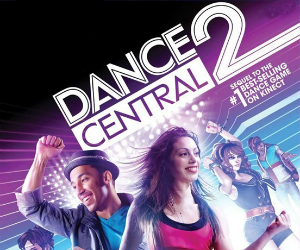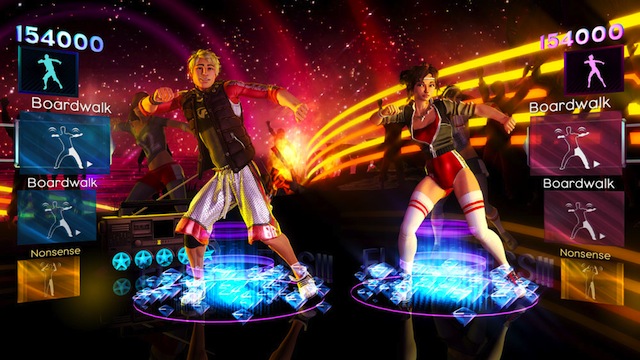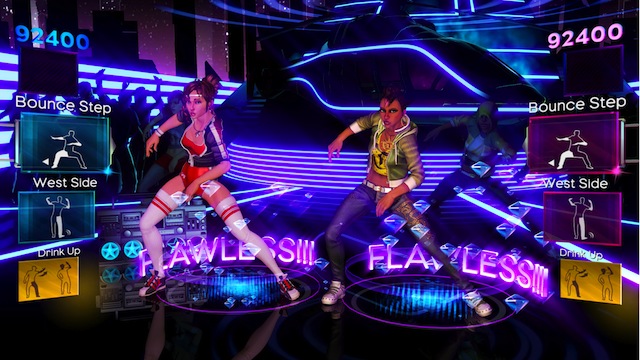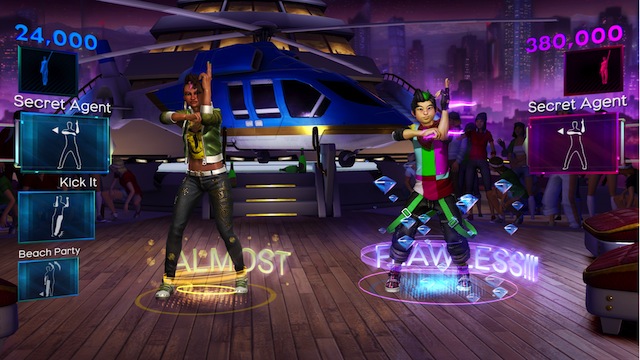Dance Central 2 Review
 Game: Dance Central 2
Game: Dance Central 2
Developer: Harmonix Music Systems
Publisher: Microsoft Studios
Available on: Kinect for Xbox 360 only
Harmonix has become synonymous with the rhythm-action genre of music games. Cutting their teeth on titles such as Frequency and Amplitude, the company was soon contracted by Konami to work on the Karaoke Revolution series. Hitting their stride with the release of Guitar Hero, the development team really made a mark on the industry. Branching out from Activision to create their own music series, Rock Band. the company further refined and defined what a rhythm-action game could be. So it is no surprise that when the new Kinect motion technology from Microsoft appeared, the team went straight to work on using the new technology for the music game genre. And so we ended up with Dance Central. The most refined dancing experience on home consoles, the game was a huge success. And now the long-awaited sequel is here, to take another stab at the dancing genre.
GRAPHICS: The same stylised graphical style from the first game has been kept in tact for this entry, however, characters have been given somewhat of a cel-shaded makeover – making them appear bolder and brighter than ever before. The overall aesthetic sticks to an urban vibe, but in a light-hearted manner, rather than go for gritty realism, which makes sense for such a casual game that is all about fun and energy. The characters in the game each belong to different dance crews, each with their own unique fashion senses and home dance location. These cover a variety of styles, such as B-Boy, R&B and Beach-Bums, and each location fits the crew in question. The animation of the characters on-screen as they dance is very smooth and natural, despite its exaggerated graphical style. All of the visuals need to be clear and strong, as players will be watching their actions as they dance, in order to mimic them. The only graphical issue is that perhaps the cards that advance on-screen, showing players what dance moves are coming up next, could be a little clearer in letting gamers know what the move is, or what action is required. Obviously, this is a difficult thing to do with one static image, but the game does rely more on the fact that you will be learning and practising moves as you go.

SOUND: The sound in the game is obviously mainly based around the musical tracks chosen to dance to. The characters in the game each have voice-overs, which fit the character design and are of a good, clear quality. Sound effects are kept to a minimum, as the game is all about the songs really. And that is where Dance Central differs somewhat from games such as Just Dance. The Ubisoft dancing title very much focuses on the very casual end of the gaming market – it did originate on Wii – and the song selection illustrates this, whereby there is a higher cheesiness quotient and a very poppy vibe overall. Dance Central is trying to capture the slightly more serious dancers and crews out there, and accordingly the soundtrack heavily features R&B and Hip-Hop, with only a handful of silly songs added in. Because of this fact, it might well be the case that Dance Central is somewhat limiting its target market. There isn’t really something for everyone, and the genre balance is very narrow, even when the silly songs do come, they are largely rap or soul-influenced. This more serious tone in music, is mirrored by the technology and performance of the title, Dance Central is a more accurate and complex gameplay experience, in comparison to Just Dance. It should also be said that for a small fee, you can also import all of the songs from Dance Central into the second game, if you own them both. This helps greatly in expanding the set list, and in offering a wider variety of tracks to dance to.
GAMEPLAY: Firstly, it should be said that the technology behind the game has been improved and tightened up greatly since the first release. the Kinect sensor tracks your movements very well, even when two players are on-screen together, crossing over one another. Your on-screen counterpart will let you know when you are, or are not, nailing moves, and their limbs will glow to show you if any part of your body is out of place. This was present in the first game, but seems somewhat clearer and more responsive this time around, helping the player to correct themselves quickly. The big change this time around is the current Kinect trend, Voice Control. Almost everything in the game can be controlled with your voice, the training menus, song selection and general options, for instance. The voice recognition actually seems more successful than most of its competitors. when tested for review, the sensor was a lot better at picking up multiple voices, both high and low, than another recent Kinect release, Kinect Sports, for example. This does help improve menu navigation, as the old system of using your left and right hands to scroll up and down could sometimes be quite difficult and time-consuming. Now the user can speak the title of a song, and get to it straight-away.
The game is structured in much the same way as the first title. Players follow the on-screen actions of the dancers and read cue-cards of upcoming moves, in order to perform the dance steps correctly and score as many points as possible – obviously, the more accurate you are in your interpretation, the higher you will score. In Perform It, dances can be performed in single player or co-operative one-off dances, or in two-player dance battles, which have received a large overhaul (more on that in the Multiplayer section).

On top of that, there is the extensive tutorial mode, known as Break It Down. This mode has, again, been improved since the first game, and offers a few new options. After choosing a song, the player can select either the whole routine, or specific moves that they want to practice. You can repeat each section until you nail it, and they can be slowed down if you have particular difficulty. This mode is very adaptive, when you nail a move, it will proceed quickly, whereas the game offers more and more levels of help when it sees you are struggling with a particular dance. you can even choose to let the game record your attempt at a move, so you can then view it alongside the on-screen dancer, to see where you are going wrong. As embarrassing as this can look, it is surprisingly helpful at showing you where you are missing part of the move, for example.
Then we get an all-new mode for the series, the Crew Challenge. This is the story-based part of the game, albeit very loosely story-based. Played as a single-player or two-player co-operative experience, gamers must visit different dance crews, and earn enough stars with your dancing to impress them and move on to another crew. Beginning with normal street dancers, the whole mode gets more dramatic and crazy as it goes on, even featuring evil robots as bosses. Extra characters and locations to dance across can be unlocked through successful completion of this mode, and to fully finish the challenge will take quite some time as there are many stars to collect, and the very nature of the game being very active will result in the fact that you won’t rush through the whole thing in one or two attempts.
And the final mode, which was featured as an option last time, but has been given its own standalone section for this sequel, is the Fitness Mode. There are two ways to experience Fitness Mode. Firstly, you can have it constantly turned on throughout all modes. This means that no matter what mode you are playing, a little heart will appear next to your on-screen avatar in the top corner, meaning that the game is tracking all of the calories you burn and how long you have been performing for. This is nice to have throughout all modes, as it makes you feel like you are doing yourself some good whilst playing! The other option is to enter the Fitness Mode menu and select from pre-determined workouts, which are set lists of specific songs. These vary from short or long workouts (different numbers of songs) to slow or fast dances, to get your blood pumping to the level you want. The good thing about fitness mode is that as you learn a routine, you will become less unsure and tentative about your performance, and you actually step up the intensity and probably get a better workout in relation to how well you know the dance moves.

MULTIPLAYER: Multiplayer Battles have been improved hugely for this sequel. In the first game, Battles were not simultaneous, and you took turns, so the new 2-player battles where you can dance side-by-side at the same time are a huge improvement. Each player picks a difficulty level first, and points are assigned accordingly, so going for easy won’t give you an advantage, it is all well-balanced. These competitive battles have also been altered slightly in this release, whereby instead of freestyle sections, which are still found in the regular mode, where you can dance however you please for a set time, you now have the chance to perform a selection of flashcard moves that appear across the screen. Both players race to complete these moves as fast as they can, in order to attain bonus points. This adds to the frantic competitive nature of the Battle mode, and adds some variety in the styles of play. Along with solo sections, where one player tries to shine whilst the other one watches, this makes the Battle mode very different from last time out. Multiplayer options are rounded out by the co-operative Crew Challenge mode and the option to play Fitness Mode with two players. All in all, the multiplayer offering is much more enjoyable in Dance Central 2 than the first and the game lends itself to drop-in, drop-out party play much better than before.
LONGEVITY: The on-disc set list is quite extensive, with around forty tracks available off the bat. Add to that the option to import the original Dance Central’s songs, and the DLC songs that can be bought via Xbox LIVE, and in theory you could keep on dancing with the title for a long time. The story mode may not be very long, but the Fitness Mode is something that you could imagine some users will come back to quite often in order to play a quick set list and get an easy workout. The game is very active, and it is entirely possible that the game could be a great fitness tool, if used properly, so the longevity of the title could really go on and on. The lack of any proper party mode, with different options or gameplay styles is a slight disappointment however, as some sort of Singstar-style team-based play would have been a welcome addition, and would have greatly added to the multiplayer lifespan of the game.
VERDICT: As stated previously, the immediate pick up and play ability of Just Dance is not present here. Dance Central 2 is more about learning and improving yourself, both in your dance skills and your fitness. The more time you put in, the more reward you get out of it. Of course not all musical tastes are catered for, but how many games can boast that claim? Guitar Hero and Rock Band are aimed at rockers, Dance Central is aimed at fans of Urban and club music, by their very design, that is hardly a shortcoming to penalise the title for. It won’t be the go-to game at parties, but it is definitely the most accurate and in-depth dancing experience that you can get on home consoles. Improvements and tweaks have been made since the first game came out as a launch title for Kinect, and the game is better in almost every way for it. You won’t find a more detailed and rewarding dance experience in video gaming than Dance Central 2.






